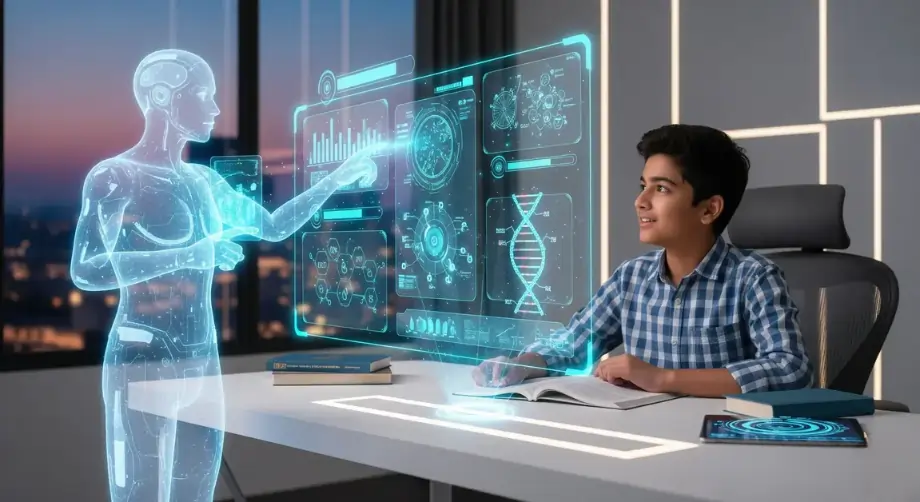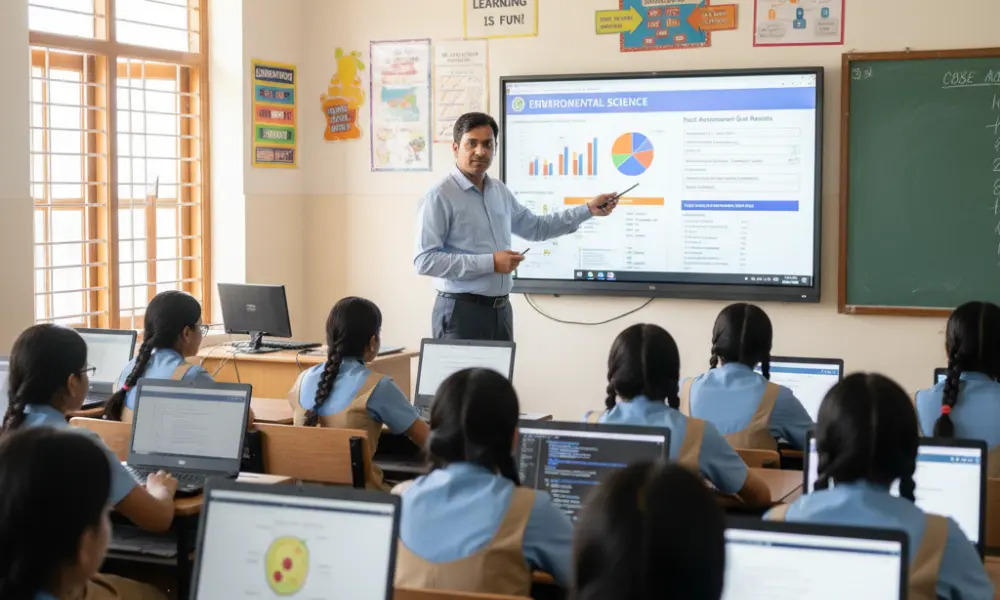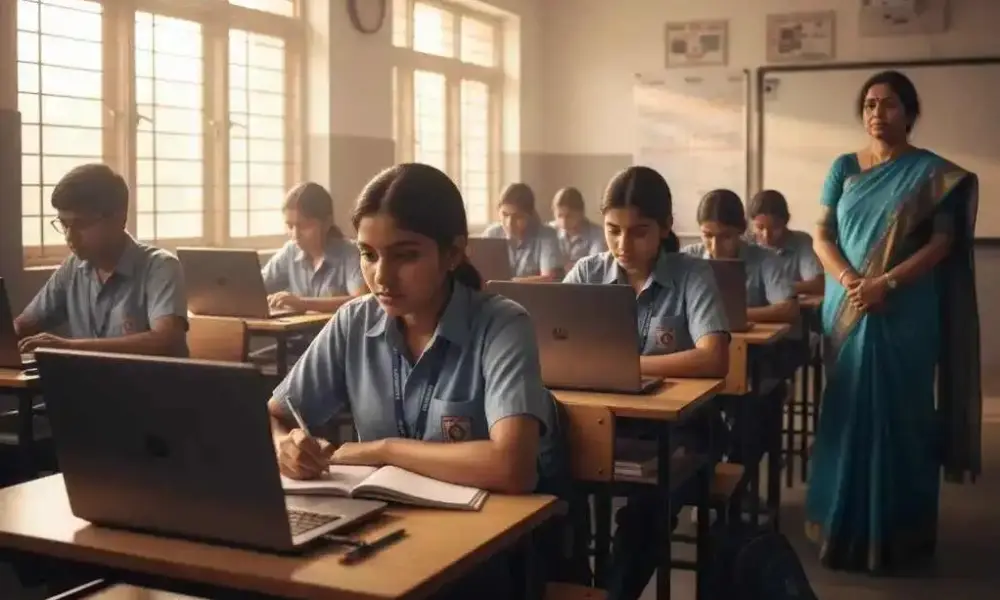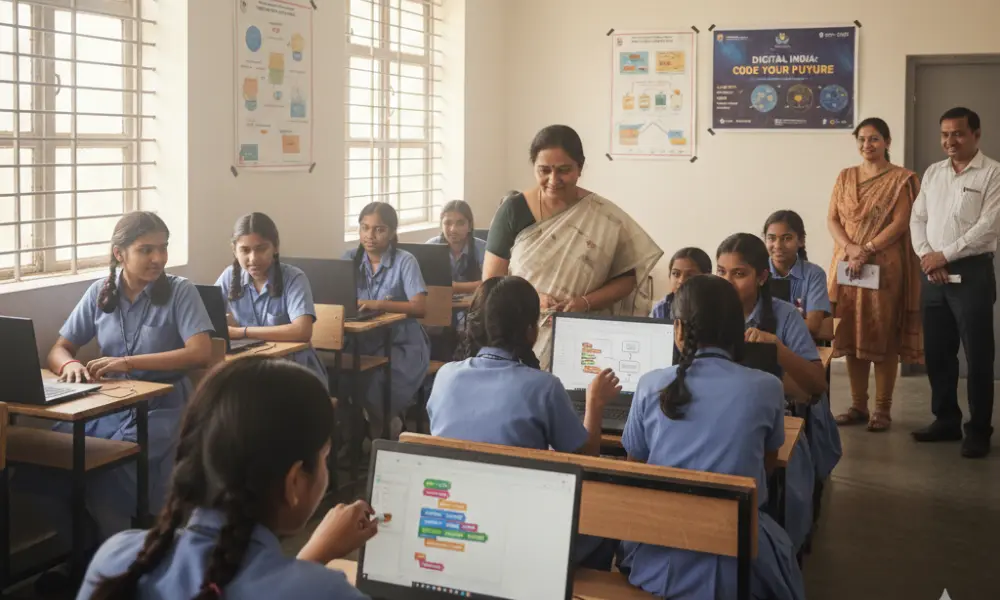How AI-powered learning is reshaping CBSE and NCERT education for millions of Indian students
Discover how artificial intelligence is transforming Indian school education through personalized learning, adaptive systems, and smart tutoring. This comprehensive guide explores AI's current impact on CBSE and NCERT students, addresses implementation challenges, and reveals what the future holds for technology-enhanced learning in Indian classrooms.

Imagine a world where every student receives personalized attention from a tutor who never gets tired, never loses patience, and adapts instantly to their learning pace. This isn't science fiction anymore – it's the reality that artificial intelligence is bringing to Indian classrooms today. From busy metropolitan schools in Mumbai and Delhi to remote village schools in rural Maharashtra and Karnataka, AI-powered education tools are quietly revolutionizing how our children learn.
For parents juggling work and family responsibilities, and students preparing for challenging CBSE and NCERT examinations, AI tutoring represents a game-changing opportunity. But like any significant shift, it comes with both exciting possibilities and important considerations that every stakeholder in Indian education needs to understand.
The adoption of AI in Indian education is happening at two distinct speeds. In urban centers, prestigious private schools and well-funded institutions are already experimenting with smart boards, AI-powered assessment tools, and adaptive learning platforms. Students in cities like Bangalore, Hyderabad, and Pune are experiencing personalized math tutorials that adjust difficulty levels in real-time and language learning apps that correct pronunciation instantly.
However, the picture becomes more complex when we look at the broader landscape. According to recent studies, less than 15% of Indian schools currently use any form of AI-enhanced learning tools. The majority of our 1.5 million schools still rely on traditional teaching methods, blackboards, and textbook-centered approaches that have remained unchanged for decades.
Yet, this gap is closing rapidly. Government initiatives like the National Education Policy 2020 explicitly encourage the integration of technology in education. States like Kerala and Gujarat have launched pilot programs introducing AI tutoring systems in select government schools, focusing initially on subjects where students traditionally struggle the most – mathematics, science, and English.
The transformation isn't just about replacing teachers with technology; it's about empowering educators with tools that make personalized learning possible for every child.
EdTech companies are also playing a crucial role. Platforms like Edzy are specifically designed for Indian curricula, understanding the unique challenges faced by CBSE and NCERT students. These platforms use AI to identify learning gaps, suggest targeted practice sessions, and even predict which topics a student might find challenging based on their performance patterns.
The magic of AI tutoring lies in its ability to understand each student as an individual learner. Traditional classroom teaching, despite teachers' best efforts, often follows a one-size-fits-all approach. A Class 10 mathematics teacher, for instance, must cover the entire CBSE syllabus at a predetermined pace, regardless of whether some students need more time with algebraic concepts while others are ready to tackle advanced geometry.
AI algorithms change this dynamic completely. They continuously analyze how a student interacts with learning material – which problems they solve quickly, where they make mistakes, how long they spend on different topics, and even which explanations they find most helpful. This data creates a unique learning profile for each student.
Consider Priya, a Class 8 student from Chennai who excels in geometry but struggles with fractions. Traditional teaching would require her to move through the curriculum at the same pace as her classmates. An AI tutor, however, recognizes her strengths and weaknesses within the first few sessions. It provides additional practice problems for fractions while allowing her to advance quickly through geometric concepts.
The algorithms track subtle indicators that human teachers might miss in a classroom of 40 students. They notice if a student consistently makes calculation errors in the final steps of problem-solving, suggesting they understand concepts but need practice with computational accuracy. They identify if a student prefers visual explanations over text-based ones, automatically adjusting the presentation style.
For NCERT science topics, AI can recognize that a student grasps theoretical concepts quickly but needs more hands-on practice with experiments and applications. The system then recommends virtual labs, interactive simulations, and real-world problem scenarios that reinforce theoretical knowledge through practical application.
Adaptive learning systems powered by AI offer several concrete advantages that directly address the challenges faced by Indian students and their families. These benefits extend far beyond simple convenience – they fundamentally improve learning outcomes and make quality education more accessible.
One of the most significant advantages is instant feedback. When Rahul from Jaipur solves a chemistry problem incorrectly, he doesn't have to wait until the next day's class to understand his mistake. The AI tutor immediately identifies the error, explains the correct approach, and provides similar problems to reinforce learning. This immediate correction prevents the formation of incorrect mental models that can persist for months in traditional learning environments.
For subjects like Hindi and English, AI can provide pronunciation feedback, grammar corrections, and writing suggestions in real-time. Students practicing essay writing for their board exams receive instant feedback on structure, vocabulary usage, and coherence – something that would require hours of a teacher's time in a conventional setting.
Indian families often struggle with rigid school schedules that don't accommodate varying family responsibilities, long commutes, or different learning preferences. AI tutoring systems are available 24/7, allowing students to learn at their optimal times. Some students are more alert in the early morning, while others concentrate better in the evening – AI accommodates these natural rhythms.
This flexibility is particularly valuable during examination periods. Students can access additional practice sessions, clarify doubts, and review difficult concepts without being constrained by teacher availability or classroom schedules.
Perhaps most importantly for India's diverse educational landscape, AI ensures consistent quality of instruction regardless of location. A student in rural Odisha can access the same high-quality explanations, practice problems, and learning resources as a student in metropolitan Delhi. This democratization of educational quality has the potential to reduce regional disparities in learning outcomes.
The promise of AI tutoring cannot be realized without acknowledging and addressing India's digital divide. While urban students increasingly have access to smartphones, tablets, and reliable internet connections, millions of students in rural and economically disadvantaged areas still lack basic technological infrastructure.
However, innovative solutions are emerging to bridge this gap. Low-cost tablets designed specifically for educational use, offline-capable AI tutoring apps, and community learning centers are making technology more accessible. Several state governments have launched programs to provide devices to students from economically weaker sections, recognizing that digital access is becoming as fundamental as textbooks.
The goal isn't to replace human connection in learning, but to ensure every child has access to personalized, quality education regardless of their economic or geographic circumstances.
Organizations are also developing AI tutoring systems that work effectively on basic smartphones and consume minimal data. These systems download essential content during periods of good connectivity and function offline when internet access is limited. For families with limited resources, this approach makes AI-enhanced learning economically viable.
Community initiatives play a crucial role too. Village libraries, community centers, and local schools are becoming hubs where students can access AI tutoring systems on shared devices. This collaborative approach not only addresses resource constraints but also maintains the social aspects of learning that are so important in Indian culture.
The successful integration of AI in Indian education depends largely on how well we prepare our teachers for this technological shift. Rather than replacing educators, AI tools are most effective when they augment human teaching capabilities. This requires a fundamental shift in how teachers perceive their role and a significant investment in professional development.
Progressive schools are already conducting workshops where teachers learn to interpret AI-generated student performance reports, understand learning analytics, and use these insights to customize their classroom instruction. Teachers are discovering that AI can handle routine tasks like grading multiple-choice tests and identifying students who need additional support, freeing them to focus on creative instruction, emotional support, and complex problem-solving guidance.
Mrs. Sharma, a mathematics teacher from Kolkata, initially worried that AI would make her irrelevant. However, after six months of using AI analytics in her classroom, she found her role had evolved in positive ways. Instead of spending hours grading papers, she now spends that time providing personalized guidance to students who need extra help. The AI system identifies exactly which concepts each student struggles with, allowing her to design targeted interventions.
Teacher training programs are focusing on helping educators become learning facilitators rather than information deliverers. This includes developing skills in data interpretation, personalized instruction design, and technology troubleshooting. Teachers are learning to ask better questions, facilitate peer-to-peer learning, and create classroom environments where AI tools enhance rather than dominate the learning experience.
Professional development initiatives are also addressing teachers' concerns about job security and technological complexity. Training programs emphasize that AI enhances teaching effectiveness rather than replacing human educators, and they provide gradual, supportive introduction to new technologies.
As AI systems collect detailed information about student learning patterns, performance, and even behavioral indicators, data privacy becomes a critical concern for parents and educators. Indian families are increasingly aware that their children's educational data represents sensitive information that must be protected from misuse.
AI tutoring platforms collect various types of data – from basic demographic information to detailed learning analytics including time spent on different topics, error patterns, and progress rates. While this data enables personalized learning, it also creates responsibilities for educational technology companies to implement robust security measures.
India is developing comprehensive data protection guidelines specifically for educational technology. These regulations require EdTech companies to obtain explicit consent from parents before collecting student data, limit data collection to educationally relevant information, and provide clear mechanisms for data deletion and portability.
Responsible AI tutoring platforms are implementing privacy-by-design approaches. They anonymize student data for algorithm improvement, use encryption for data transmission and storage, and provide transparent privacy policies that parents can easily understand. Some platforms, including Edzy, allow parents to review exactly what data is collected about their children and how it's used to enhance learning.
Schools and parents need to evaluate AI tutoring platforms based on their privacy practices, not just their educational effectiveness. Questions about data retention periods, third-party data sharing, and security breach protocols should be part of any evaluation process.
Looking ahead, the integration of AI in Indian education is likely to accelerate significantly over the next decade. Several trends are emerging that will shape how students learn and teachers instruct in the coming years.
Voice-based AI tutors are becoming increasingly sophisticated, allowing students to ask questions in their native languages and receive explanations in Hindi, Tamil, Bengali, or other regional languages. This linguistic adaptability will make AI tutoring more accessible to students who are more comfortable learning in their mother tongue, particularly in rural areas where English proficiency may be limited.
Future AI systems will likely predict learning difficulties before they become apparent to students or teachers. By analyzing subtle patterns in how students interact with learning materials, AI could identify potential challenges weeks or months in advance, allowing for proactive intervention rather than reactive remediation.
Imagine an AI system that notices a Class 9 student is developing misconceptions about atomic structure based on their problem-solving approaches. Instead of waiting for these misconceptions to surface during exams, the system could immediately provide targeted explanations and alternative learning resources to address the issue.
Integration with virtual and augmented reality will create immersive learning experiences particularly valuable for subjects like history, geography, and science. Students studying the Mughal Empire could virtually explore historical sites, while those learning about human anatomy could examine 3D models and interactive systems.
Future AI tutoring systems will likely facilitate collaborative learning by intelligently matching students with complementary strengths and weaknesses. A student who excels in mathematical concepts but struggles with problem-solving speed might be paired with a peer who has the opposite profile, with AI facilitating their collaborative learning sessions.
AI will also become better at creating learning communities, connecting students across schools and regions who are working on similar topics or facing similar challenges. This could help address the isolation that some students feel and create support networks that extend beyond individual classrooms.
While AI tutoring offers remarkable capabilities, maintaining the human elements of education remains crucial for holistic student development. Indian educational philosophy has always emphasized the importance of the guru-shishya relationship, recognizing that learning involves emotional, social, and character development alongside academic achievement.
The most effective implementations of AI in education preserve and enhance human connections rather than replacing them. AI handles routine, repetitive tasks and provides personalized practice opportunities, while human teachers focus on inspiration, creativity, critical thinking, and emotional support.
The future of Indian education lies not in choosing between human teachers and AI tutors, but in creating synergies that leverage the strengths of both.
Students still need human mentors who can provide career guidance, help them navigate personal challenges, and model important life skills. They need peer interactions that develop communication abilities, teamwork skills, and cultural understanding. AI should enhance these human connections by creating more time and opportunities for meaningful interactions.
The ideal educational environment combines AI-powered personalization with rich human interaction. Students might use AI tutors for individual skill practice and concept reinforcement, while participating in teacher-led discussions, group projects, and collaborative problem-solving activities.
This blended approach also addresses the concern that excessive technology use might reduce students' ability to focus, think deeply, or engage in face-to-face communication. By thoughtfully integrating AI tools with traditional teaching methods, educators can preserve the benefits of both approaches.
Parents play a crucial role in maintaining this balance. They can monitor their children's screen time, encourage offline learning activities, and ensure that AI tutoring supplements rather than replaces human interaction and outdoor play.
Beyond improving current learning outcomes, AI tutoring systems can help prepare Indian students for a future where artificial intelligence will be integrated into many aspects of work and life. Students who learn to collaborate effectively with AI tools, understand their capabilities and limitations, and maintain their uniquely human skills will be well-prepared for future career opportunities.
This preparation includes developing critical thinking skills to evaluate AI-generated information, creativity to solve problems that AI cannot address, and emotional intelligence to work effectively in human teams. AI tutoring can actually enhance these skills by handling routine learning tasks and creating more time for complex, creative activities.
The AI tutoring revolution in Indian education represents an opportunity to address longstanding challenges while preparing students for future success. By thoughtfully implementing these technologies, supporting teacher development, addressing equity concerns, and maintaining the human connections that make learning meaningful, we can create an educational system that serves every Indian student more effectively.
For parents considering AI tutoring options, the key is finding platforms that align with Indian educational values, respect student privacy, and enhance rather than replace human relationships. For educators, the challenge is embracing new tools while preserving the wisdom and warmth that make great teaching an art as much as a science.
As we move forward, the success of AI in Indian education will depend not just on technological advancement, but on our collective commitment to ensuring that every child – regardless of their background, location, or economic circumstances – has access to personalized, high-quality learning opportunities that prepare them for a bright future.

Chatbots, AI Tutors, and Beyond: The Future of Smart Classrooms in CBSE Schools
Exploring the transformative role of AI in CBSE education

The Future of CBSE Examinations – AI, Adaptive Testing, and What Lies Ahead
How AI and adaptive testing could reshape CBSE exams for future-ready students

The Growing Role of Coding and AI in CBSE Curriculum – What Parents Should Know
How CBSE’s focus on coding and AI is shaping students’ future and what parents can do to help

How Ed-Tech Tools Are Helping Students With Learning Disabilities Thrive
How inclusive technology is transforming learning for CBSE students with dyslexia, ADHD, and other challenges